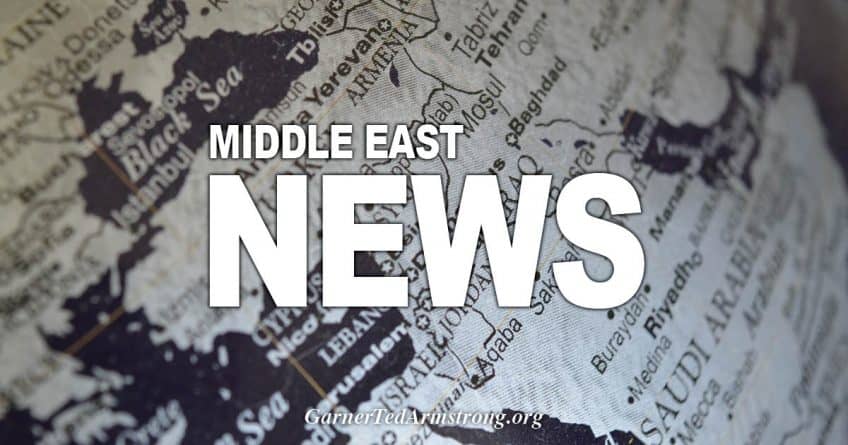The Middle East is a collection of countries that, by and large, do not work and play well together. It is not going to get better any time soon.
A half-century ago, the author received his first real taste of how professionals viewed international relations — beyond the daily, often-scary headlines in the middle of the Cold War — from the vantage point of an introductory course at university. Besides a ton of weighty journal articles to digest, the class’s main textbook gave what seemed to this new reader in the field to be a revolutionary approach.
Aha! Here it was. International relations wasn’t just about those dastardly Soviets trying to take over the world through their proxies, those nefarious Chinese, Vietnamese, or North Koreans. International relations was actually built on a set of larger organizing principles and ideas that existed well beyond the specifics of a particular space or a unique time. These principles about balances of power, alliances, and zero-sum and non-zero-sum games were as true three millennia ago in the “Warring States” period of Chinese history as they were in the 19th and early 20th centuries’ hundred years of the “Concert of Europe”. In fact, they could just as easily be useful in understanding today’s world.
Now, apply that understanding and focus on the space on the map where Asia, Africa and Europe converge, to the place — sometimes confusingly — that is simultaneously called both the Middle East and the Near East. (The explanation to that puzzle is that 19th-century British geographers had used the Middle East to cover the area between the Near East and India. There. Now you know.)
So, pay special attention to a crucial quadrilateral of nations in the region, namely: Turkey, Iran, Saudi Arabia, and Israel. Secondarily, there are also Iraq, Egypt, Syria, Lebanon, Jordan, and the gaggle of the Gulf states, operating in the background. By this point, this is already a pretty complex “warring states” system within that two-tiered roster. But that is still before the United States, Russia and a batch on non-state actors such as Daesh/IS/Isis and the Kurds inside the various states delineated by lines on maps are also stirred into the mix.
Now we really have a complicated diagram, but we still have to add a few more things. There is an ocean of oil and natural gas, lots of dangerous high-tech weaponry, a few nuclear weapons — and some really long-standing grievances, some of which go back 1,300 years or so. And also added to this mix are some tense, still-unresolved border issues, floods of refugees, and the usual miscellaneous, nihilist terrorists.
Back in the early 1970s, Iran was seen by some, along with a list of countries such as Brazil, India, Indonesia, South Africa, and Japan, as the mini-hegemons of their respective regions. They were countries that could be charged with keeping their regions stable from the depredations of would-be forces of instability, chaos, and disaster. Sometimes it might be through military capabilities, and in other cases, it could be from the sheer force of their economic heft, such as in the case of Japan. In the context of the Cold War, from the American point of view, the objective of this idea was to envision a key element in a more stable global system, right amid the larger, dangerous, overarching Cold War dynamic.
If readers haven’t already guessed, the intellectual force behind this conceptual system was a combination of then-president Richard Nixon and his secretary of state and national security adviser, Henry Kissinger. This is the team that, among other things, gave us the modern use of the idea of global triangulation. In this idea, the US would move adroitly to create a connection to China, amid that historic “Sino-Soviet Split” and even as the US was still fighting in Vietnam. But you knew the provenance of both those notions already, right?
With this history as preamble, now focus on today’s challenge: That strategically important quadrilateral of Turkey, Iran, Saudi Arabia and Israel. It may be surprising to some readers, but there was a time, not so very long ago — until 1979 in fact, where all four of these nations was closely tied to the US via various versions of an alliance partnership.
Iran
Once the prime ministership of Mohammad Mosaddegh had been overthrown back in 1953, the ruling Shah of Iran built increasingly close ties, over nearly two generations, with Americans. American companies flooded into the country to build the oil industry, modern telecommunications networks and other industries, and, naturally, for increasingly close military co-operation as well.
One thing this co-operation also achieved, however, was an increasing sense of dislocation for many in many parts of the country. Numbers of students opposed the heavy hand of the shah’s secret police, Savak; the Muslim clergy was repelled by the apparent ongoing westernization and secularization of the country; and the traditional population — out beyond the cosmopolitan nouveau riche of Tehran — located throughout the country’s small towns, villages and farms, was angered by the increasing concentration of new wealth in the capital.
By the time the students rebelled, the Muslim clergy was poised to hijack that revolt, and Americans quickly became the prime enemy by virtue of their ties to and championing of the shah and all his works. Result: No more close relationship with the Great Satan.
Turkey
Meanwhile, since the end of the Second World War, Turkey had become an increasingly key part of Nato’s “southern flank” against the Soviet Union, hosting major US air bases in the country. Among many Turks, after the end of the Cold War and the Soviet Union, there was a growing sense of interest in joining the expanding EU — and, simultaneously, frustration that the country’s modernized westernness and its role as a bridge between Europe and Asia was being less than enthusiastically embraced by the west.
Thereafter, to add strains to its politics, some in Turkey have been increasingly affected by the rise in radical Islam elsewhere even as there always has been a persistent problem in Turkey’s dealings with the Kurdish population in the eastern part of the country. These are people whom most Turks see as a rebellious force capable of causing much turmoil, even without connections to Kurdish populations in Syria, Iraq, and Iran.
In the current moment, the Turkish-US relationship has come under growing strains for reasons such as American co-operation with Syrian Kurds and a Turkish insistence that an expatriated, elderly cleric/teacher should be shipped home from America to face the music as a coup plotter.
Saudi Arabia
Meanwhile, to the south, the Saudis had been cautiously building closer ties with the US, ever since President Franklin Roosevelt’s meeting with King Ibn Saud during of World War II. Postwar, American petroleum exploration and lifting companies became increasingly prominent factors in the kingdom.
Eventually, the US built up a strong military presence there, and the fighting in Gulf War I — the 1991 liberation of Kuwait from Iraq and the concomitant humiliation of Saddam Hussein’s invading army — was launched from Saudi bases. The incumbent president’s first foreign visit was with the Saudi king (complete with that strange glowing crystal orb and sword dance), cementing a tightening tie via two ultra-ambitious men, the president’s adviser and son-in-law, Jared Kushner, and the young Saudi crown prince, Mohamed bin Salman. That personal (and national) relationship seemed rock solid until Washington Post columnist Jamal Khashoggi was assassinated inside the Saudi consulate in Istanbul last year.
Israel
And then there is Israel. Since its inception as a sovereign state in 1948, the relationship with the US has grown much stronger. (Interestingly, at its birth, Israel’s major international state supporters included the Soviet Union and its new Eastern European satellites by virtue of Israeli founder politicians’ political and economic orientations as solid socialists. During the 1956 Suez War, then-president Eisenhower had demanded withdrawal of the UK, French and Israeli forces from the Suez Canal and the Sinai — or else. Thereafter, the ties have become ever closer.)
Especially since the 1967 and 1973 wars between Israel and its neighbours, Israel has become the pre-eminent regional military superpower and the most technologically advanced nation in the area (including its undeclared possession of nuclear weapons). While its occupation of the West Bank since 1967, and a continuing programme of new Jewish settlements in those territories have begun to soften American Jewish (and some other) support for Israel, political support for Israel among American Christian evangelical fundamentalists has actually grown stronger. That, in turn, has helped stiffen support for Israel among politicians in the US, in particular, those beholden to support from the evangelicals for their political fortunes.
The quadrilateral
And so, here are four powerful neighbouring nations, each of which has — or have had — close ties with the US — and frequently fraught ones with one another. But the 2011 Arab Spring in Syria changed the game. Initially, it seemed just possible that rebel groups might overthrow longtime dictator/president Bashar al Assad, that is until the Russians, eager to protect their naval and air power assets and their position in the Mediterranean, began to bulk up men and weaponry in Syria, and in conjunction with Syrian government forces, increasingly carried out combat missions against the various rebel groups. Predictably, the results have been especially dire for places like Homs and Aleppo, even as Assad’s forces gained the upper hand over much of the country.
Meanwhile, Syrian Kurds seized the moment (and territory) to stake out a claim for autonomy in the north and east, and Daesh/IS, expanding from their base in northern Iraq in the wake of the US’s substantive pullback of forces in Iraq, entered into Syria along the Euphrates River and nearby settled areas in the southeast.
The US sent in a limited number of advisers and tactical support forces, largely supporting the Kurds battling Daesh (backed up by those US ground and air forces still in Iraq). By that point, millions of Syrian refugees, fleeing the fighting, were entering southern Turkey. Amid all of this, Israeli forces were increasingly paying attention to Iranian military forces in Syria, the Quds Force, monitoring Syrian air force operations against the remaining rebels and the capabilities of Russian anti-aircraft missiles in Syria, and Russian air cover for Syrian operations. Occasionally the Israelis have attacked some facilities of one or another of the forces supporting the Syrian government, just in case.
Meanwhile, the airspace over Syria has been alive to the possibility that fatal accidents or clashes could bring the various nations operating in that space into a hot confrontation — or worse. Stuff like that can happen, almost without warning, even though there is a kind of informal heads-up system over airborne operations.
While all this was occurring, the Saudis and Iranians have simultaneously engaged in a particularly vicious proxy war for dominance in Yemen. The Saudis are backing what passes for the established government, and the Iranians are supporting the Houthi rebels. In their efforts, the Saudis are largely dependent on the US for much of its hi-tech weaponry, midair refuelling, and signals intelligence. Regardless of who has done the attacking, this war has produced a staggering human toll on Yemen’s civilians, from the collateral damage of bombing errors to famine and on to outbreaks of epidemic diseases such as typhoid and cholera.
As things stand now, the four nations — Saudi Arabia, Iran, Turkey, and Israel — remain locked in jockeying for greater security and influence in the region, even as major Russian forces remain in Syria, smaller numbers of American forces are also in the country (even as Donald Trump had announced their immediate withdrawal, having defeated Daesh), and a small number of US forces are still based in Iraq as well. The US airbase in Incirlik, Turkey remains in service, but given the tensions between the US and Turkey its forces have been precluded from operations against Turkish forces or their proxies — or to carry out operations in support of the Kurds in Syria, lest the Turks take umbrage over that.
Meanwhile, the Saudis and the Israelis have — despite decades of non-recognition, strong Saudi hostility towards Israel in international forums, and near-hostilities on the battlefield — formed a tacit alliance against Iran’s actions in the region. Along the way, various other Gulf states have increasingly fallen in line with this connection, and, as a result, any former obsessions on the Palestinian cause have significantly faded into the background — in view of the current larger struggle for dominance in the region.
There is no regional or international body empowered to bring these rivalries under control. Save for that transactional, tacit Saudi-Israeli tie, the objectives of the national players remain divergent. The Iranians want to be able to exercise their desired dominant place from the southern Arabian Peninsula to Syria (in alliance with the Alawite strain of Islam in Syria that is very similar to Iran’s Shia beliefs). The Saudis, meanwhile, are insistent on reasserting their own sense of dominance as the region’s leader and moral guide for the Middle East’s main religion (and here, in opposition to Iran’s Shia allegiance).
Meanwhile, Turkey, too, has intentions to reassert its own historic sense of superiority in the region. It did, after all, rule virtually the entire region, even including chunks of modern Iran, for half a millennium, and its economic power has great weight as well. As for Turkey’s most immediate goals, the key for them is in keeping Kurdish nationalism in check wherever it is located, lest that inspire the Turkish Kurds; and simultaneously in keeping Iranian influence in Syria within the narrowest possible limits. While Turkey under President Recip Erdogan has moved closer to Russia in several ways, it would also hope to have the Russian presence in Syria kept within limits as well.
And for the Israelis? The present moment is alive with both danger and possibilities. The danger comes in having a potent array of Russian and Iranian anti-aircraft and other missiles along its northern border, together with those experienced, battle-hardened Quds Force fighters, a possible force to contend with in the years ahead. Its formerly close ties with Turkey have attenuated, even as it now has informal, but real connections to Saudi Arabia and the Gulf States. But from their perspective, the real strategic challenge comes from Iran and its arsenal of middle-range and longer-range missiles.
But the Israelis also have an election coming up, and Prime Minister Binyamin Netanyahu and his one-vote majority in the Israeli parliament may be coming under pressure by the rise of Benny Gantz, a genuine military hero and, at least in contrast to the incumbent, a man who may be able to overturn decades of political and international stalemate. If he wins, perhaps he can find some path forward among the quadrilateral.
Quo Vadis, the Americans?
And then there is the future of the Americans in the region. While there is much public endorsement of Israel and the move if the embassy to Jerusalem, there is also a visible disengagement from the region, besides a drumbeat of criticism towards Iran. Under President Trump, the American pullback from Syria and Iraq (and Afghanistan), and the idea that the days of any US boots on the ground in the area are numbered may create further instability. It is a reasonable argument that that initial intervention in Syria was poor policy, or worse. But that does not necessarily mean their absence will be better.
Conservative internationalist columnist Max Boot, writing in The Washington Post the other day, argued:
“These kinds of deployments are invariably lengthy and frustrating. Think of our Indian Wars, which lasted roughly 300 years (circa 1600-1890), or the British deployment on the North West Frontier (today’s Pakistan-Afghanistan border), which lasted 100 years (1840s-1940s). US troops are not undertaking a conventional combat assignment. They are policing the frontiers of the Pax Americana. Just as the police aren’t trying to eliminate crime, so troops are not trying to eliminate terrorism but, instead, to keep it below a critical threshold that threatens the United States and our allies. This isn’t as satisfactory as pursuing unconditional surrender, but, as we may discover before long, it beats the alternative.”
Regardless of whether Boot or Trump is right, what is stunningly clear is that Trumpian decision making is being made on a whim, rather than listening carefully to the strategic professionals in government (including those he appointed) and then thinking through consequences.
Those professionals are the very ones he has once again ridiculed in public because they failed to parrot his faux facts about Iran’s supposed noncompliance with the nuclear accord signed in the waning days of the Obama administration. Will they be more prepared to tell the emperor unpalatable facts in the future, or let him live with his own fantasies? DM
Source: https://www.dailymaverick.co.za/article/2019-02-01-the-middle-east-vortex-may-become-even-worse/
[Disclaimer]








